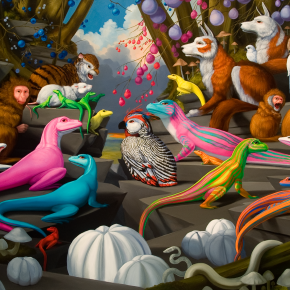Art / Laurie Hogin
- Diorama with Xanax and Bruised Fruit; 2011; oil on canvas; 23.36″ x 48″
- Pharmaceutical Guinea Pigs (Prozac); 2004; oil on panel; 7.75″ x 7.75″
- Amygdala Cranes; 2014; oil on canvas; 26″ x 22″
From the writer
:: Account ::
Pictures are ideological; pictorial conventions imply narratives: historically, landscape, still life, portraiture; now, advertising, cinema, Instagram. I hybridize strategies from painting’s history with contemporary pictorial conventions. Species are allegorical and are mutated, exaggerated, or degraded: they are lurid hues of big-box store commodities and pixilated palettes; their morphology resembles toys and cartoons, the literal embodiment of all they live with. They inhabit places that are overgrown or apocalyptic, florescent and fluorescent.
Diorama with Xanax and Bruised Fruit
Dioramas have fascinated me ever since childhood. They are tendentious narratives about nature, frozen in time, dead yet presented as though living. They represent certain cultural practices regarding “nature”: imperialism, consumerism, transcendentalism, spirituality, poetry, and even rationalist philosophies incepted by immersion in “the natural world.” Dioramas were like alternate homes to me, spaces where time was suspended and I imagined I was safe from my real life, and the stillness, death, and artifice meant I was safe from real, raw nature. I’ve done at least a hundred “diorama” works wherein the plants and animals have been invaded, poisoned, mutated, or otherwise inflected with overwhelming and inappropriate chemistries. In this one, the fruits are the colors of bruised flesh, suggesting that violence has influenced the ecosystem. The presence of the drug is an attempt to ameliorate its effects. These references to violence and drugs are intended to present a narrative metaphor for any number of situations in which “poisoning” and “palliation” may be operative.
Pharmaceutical Guinea Pigs (Prozac)
Prozac is one of the works in the first series of Pharmaceutical Guinea Pigs, which has four similar pink, toothed, unsettled, mutant guinea pigs, each named for an antidepressant. I use the guinea pig as an icon of scientific objectification and experiment, because it is a laboratory animal (and they are shaped like pills!), to suggest that our positivist culture puts greater faith in pharmaceutical intervention in mood processes than perhaps it should. Probably sometimes low mood is endogenous; clearly, many times it is narrative, resulting from trauma. My guinea pigs suggest that medicating for emotions can be problematic.
Amygdala Cranes
The amygdala, a region of the brain involved in motivation, emotion, and emotional behavior, is activated by all sensory experiences. Research suggests it plays a role in acquisition and consolidation of emotionally charged memories. I’m interested in how such memories become language, symbols, and metaphors, and how sensory inputs like color, sound, scent, physical pain, pleasure, or social and emotional context develop latent meanings through association with earlier experience and subsequent naming, categorization, and narrative. This painting was part of a solo exhibition titled Amygdala. Topics in that show included the idea that representational strategies and gestures inherent in painting present memory and emotional experience as simultaneously embodied and symbolized. Cranes engage in courtship dances, a fact which occasions many hypotheses about the nature of the emotional, embodied experiences of what we call love and the many ways in which those experiences are reified in language and culture.
Best known for paintings of mutant animals in lurid, overgrown landscapes, Laurie Hogin examines human desires and needs, including pleasure, violence, greed, and love, describing political, economic, and emotional phenomena. Her work has been exhibited nationally and internationally for 23 years, and is in multiple public and private collections. Hogin lives and works in Mahomet, Illinois, with her husband, their 15-year-old son, and some animals. She is a Professor of Painting at the University of Illinois.



